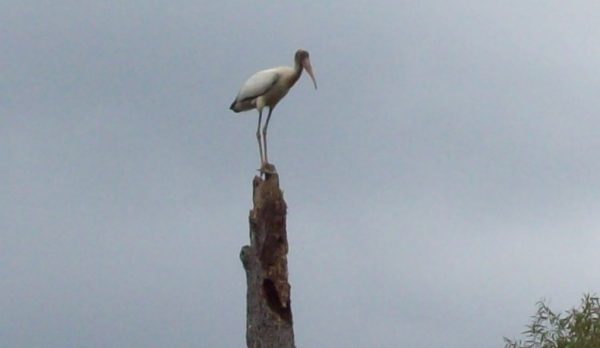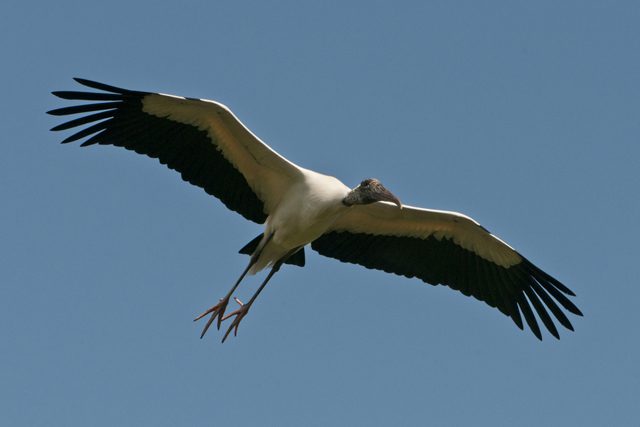A native stork – heading north?

A few years ago at the Pee Dee National Wildlife Refuge in Anson County, we spotted an interesting species, thought to be out of its natural range – the wood stork (Mycteria americana).
This was during a meeting of the Greater Uwharrie Conservation Partnership, and we saw four wood storks, all juvenile, perched on dead standing trees in a marshy area.
The wood stork is North America’s only stork species. In the past it was called the wood ibis, but it is not an ibis, although the head resembles that of an ibis, hence the name. They are white with black-gray legs and pink feet, and their head is dark brown with a bald gray to black face and neck. They are approximately 45 inches tall with a wingspan of 5 feet. They have a long bill, up to 10 inches in length, and it is curved. Unlike herons, they fly with their neck stretched out.
They are found in the Caribbean, Central and South America, and in North America north to North Carolina and west to Mississippi. They breed in Florida, Georgia and South Carolina. Wood storks are found in marshy habitats, in coastal areas, tidal pools, swamps and mangroves. They eat fish, frogs, mollusks, snails and insects. The wood stork hunts with its bill open in the water, and when it feels prey it quickly closes its mouth. The average response time is 25 milliseconds, making it one of the fastest reflexes among vertebrates. Wood storks breed in Florida’s late winter dry season, when fish congregate in shrinking pools.
Wood storks nest in colonies, building stick nests in trees. There may be as many as 25 nests in a single tree. Wood stork pairs often mate for life and may return to the same nesting site year after year. Both the male and female build the nest and care for the young. The Florida everglades are the stronghold of the breeding population in the United States. In drought years, which have been more frequent recently, raccoons –the top predator of juvenile wood storks – can more easily get into the nests. Adult wood storks do not have a major predator, although they can be taken by alligators.
Once classified as endangered (listed in 1984), they were upgraded in 2014 and the U.S. Fish and Wildlife Service now classifies them as a threatened species by. The Southeast breeding population declined from 20,000 pairs in the 1930s to about 5,000 pairs in the late 1970s. Since 2004, the number of nesting pairs has remained above 6,000. The current estimated breeding population is believed to be greater than 8,000 pairs.
Restoring wetlands has been key to the increased number of wood storks found, especially as the species expanded its range into North Carolina and Mississippi. But the species is still threatened by habitat loss from wetland destruction, levee and canal construction that changes water flow, invasive species and pollution. Pythons, an invasive species in the everglades, are another source of pressure on the species. In addition, pesticides and mercury that accumulates in fish are also responsible for the death of some wood storks.
Preserving their habitat, both for breeding and foraging, is one key way to help keep wood storks off the endangered list.
 Wood stork in flight. Photo: Mandcrobertson (Own work) [CC BY-SA 3.0 (http://creativecommons.org/licenses/by-sa/3.0)], via Wikimedia Commons
Wood stork in flight. Photo: Mandcrobertson (Own work) [CC BY-SA 3.0 (http://creativecommons.org/licenses/by-sa/3.0)], via Wikimedia Commons